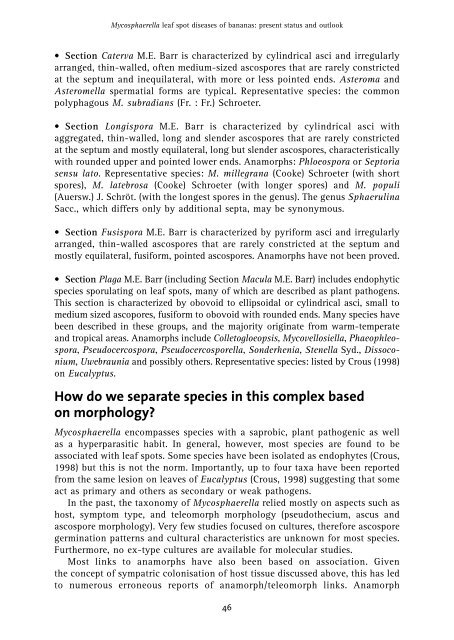Mycosphaerella leaf spot diseases of bananas - CBS
Mycosphaerella leaf spot diseases of bananas - CBS
Mycosphaerella leaf spot diseases of bananas - CBS
You also want an ePaper? Increase the reach of your titles
YUMPU automatically turns print PDFs into web optimized ePapers that Google loves.
<strong>Mycosphaerella</strong> <strong>leaf</strong> <strong>spot</strong> <strong>diseases</strong> <strong>of</strong> <strong>bananas</strong>: present status and outlook<br />
• Section Caterva M.E. Barr is characterized by cylindrical asci and irregularly<br />
arranged, thin-walled, <strong>of</strong>ten medium-sized ascospores that are rarely constricted<br />
at the septum and inequilateral, with more or less pointed ends. Asteroma and<br />
Asteromella spermatial forms are typical. Representative species: the common<br />
polyphagous M. subradians (Fr. : Fr.) Schroeter.<br />
• Section Longispora M.E. Barr is characterized by cylindrical asci with<br />
aggregated, thin-walled, long and slender ascospores that are rarely constricted<br />
at the septum and mostly equilateral, long but slender ascospores, characteristically<br />
with rounded upper and pointed lower ends. Anamorphs: Phloeospora or Septoria<br />
sensu lato. Representative species: M. millegrana (Cooke) Schroeter (with short<br />
spores), M. latebrosa (Cooke) Schroeter (with longer spores) and M. populi<br />
(Auersw.) J. Schröt. (with the longest spores in the genus). The genus Sphaerulina<br />
Sacc., which differs only by additional septa, may be synonymous.<br />
• Section Fusispora M.E. Barr is characterized by pyriform asci and irregularly<br />
arranged, thin-walled ascospores that are rarely constricted at the septum and<br />
mostly equilateral, fusiform, pointed ascospores. Anamorphs have not been proved.<br />
• Section Plaga M.E. Barr (including Section Macula M.E. Barr) includes endophytic<br />
species sporulating on <strong>leaf</strong> <strong>spot</strong>s, many <strong>of</strong> which are described as plant pathogens.<br />
This section is characterized by obovoid to ellipsoidal or cylindrical asci, small to<br />
medium sized ascopores, fusiform to obovoid with rounded ends. Many species have<br />
been described in these groups, and the majority originate from warm-temperate<br />
and tropical areas. Anamorphs include Colletogloeopsis, Mycovellosiella, Phaeophleospora,<br />
Pseudocercospora, Pseudocercosporella, Sonderhenia, Stenella Syd., Dissoconium,<br />
Uwebraunia and possibly others. Representative species: listed by Crous (1998)<br />
on Eucalyptus.<br />
How do we separate species in this complex based<br />
on morphology?<br />
<strong>Mycosphaerella</strong> encompasses species with a saprobic, plant pathogenic as well<br />
as a hyperparasitic habit. In general, however, most species are found to be<br />
associated with <strong>leaf</strong> <strong>spot</strong>s. Some species have been isolated as endophytes (Crous,<br />
1998) but this is not the norm. Importantly, up to four taxa have been reported<br />
from the same lesion on leaves <strong>of</strong> Eucalyptus (Crous, 1998) suggesting that some<br />
act as primary and others as secondary or weak pathogens.<br />
In the past, the taxonomy <strong>of</strong> <strong>Mycosphaerella</strong> relied mostly on aspects such as<br />
host, symptom type, and teleomorph morphology (pseudothecium, ascus and<br />
ascospore morphology). Very few studies focused on cultures, therefore ascospore<br />
germination patterns and cultural characteristics are unknown for most species.<br />
Furthermore, no ex-type cultures are available for molecular studies.<br />
Most links to anamorphs have also been based on association. Given<br />
the concept <strong>of</strong> sympatric colonisation <strong>of</strong> host tissue discussed above, this has led<br />
to numerous erroneous reports <strong>of</strong> anamorph/teleomorph links. Anamorph<br />
46

















